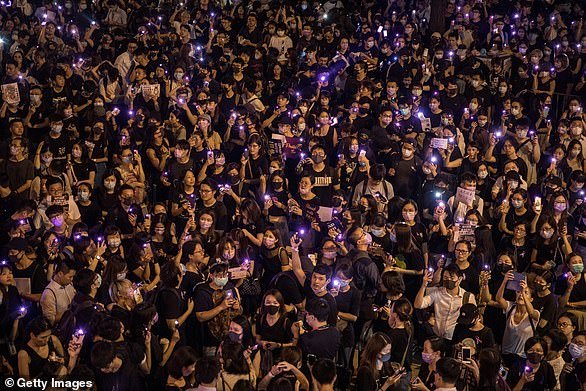2019
February – Hong Kong’s Security Bureau proposes amendments to extradition laws that would allow extraditions to mainland China and other countries not covered by existing treaties.
March 31 – Thousands take to the streets to protest against the proposed extradition bill.
April 3 – Hong Kong leader Carrie Lam’s government introduces amendments to the extradition laws that would allow criminal suspects to be sent to mainland China for trial.
April 28 – Tens of thousands march on Hong Kong’s Legislative Council to demand the scrapping of the proposed amendments.
May 30 – Concessions to the extradition bill are introduced but critics say they are not enough.
June 6 – More than 3,000 Hong Kong lawyers dressed in black take part in a rare protest march.
June 9 – More than half a million people take to the streets.
June 15 – Lam indefinitely delays extradition law.
July 1 – Protesters storm the Legislative Council on the 22nd anniversary of the handover from British to Chinese rule, destroying pictures and daubing walls with graffiti.
July 9 – Lam says the extradition bill is dead and that government work on it had been a ‘total failure’.
Protesters are pictured waving their phones in a demonstration on August 28, 2019
July 21 – Men in white T-shirts, some armed with poles, storm a train at rural Yuen Long station, attacking passengers and passersby, after several thousand activists surrounded China’s representative office. The pivotal attack triggers a massive backlash against the police, who were accused of being slow to respond.
July 30 – Forty-four activists are charged with rioting, the first time the charge has been used during the protests.
August 9 – China’s aviation regulator demands Hong Kong flag carrier Cathay Pacific suspend personnel who have taken part in the protests. The airline suspends a pilot, one of the 44 charged, the next day.
August 14 – Police and protesters clash at Hong Kong’s international airport after flights were disrupted.
August 21 – Alibaba, China’s biggest e-commerce company, delays its Hong Kong listing of up to $15 billion.
September 2 – Lam says she has caused ‘unforgivable havoc’ and would quit if she had a choice, according to a recording of remarks to business people.
September 4 – Lam announces the extradition bill will be withdrawn. Critics say it is too little, too late.
September 17 – Lam pledges to hold talks with the community to try to ease tensions.
September 26 – Protesters trap Lam in a stadium for hours after her first ‘open dialogue’.
October 1 – City rocked by the most widespread unrest since the protests began as China’s Communist Party rulers celebrate the 70th anniversary of the founding of the People’s Republic. Police shoot an 18-year-old protester in the shoulder.
October 4 – Lam invokes colonial-era emergency powers to ban face masks, sparking violent protests. A police officer shoots a 14-year-old boy in the thigh.
October 16 – Lam abandons her policy speech amid lawmakers’ jeers. Prominent rights activist Jimmy Sham is beaten by four men wielding hammers and knives.
October 23 – Extradition bill is withdrawn.
October 29 – Authorities disqualify pro-democracy activist Joshua Wong from standing in upcoming district elections.
November 2 – Protesters vandalise China’s official Xinhua news agency, smashing doors, setting fires and throwing paint.
November 4 – University student Chow Tsz-lok, 22, falls from the third to the second floor of a parking lot as police disperse protesters.
November 6 – A knife-wielding man attacks pro-Beijing lawmaker Junius Ho.
November 8 – Chow dies, the first student death during the protests.
November 11 – Police fire live rounds at protesters on the eastern side of Hong Kong island, one person wounded.
November 17-29 – Protracted, at-times fiery siege at the Hong Kong Polytechnic University as police surround campus after students and activists barricaded themselves inside. More than 1,100 mostly young activists arrested in what was widely seen as the police’s first major success against the movement.
2020
January 1 – A march drawing tens of thousands on New Year’s Day spirals into chaos as police fire several rounds of tear gas and water cannon at crowds, including families, before halting event.
April 17 – Beijing’s top representative office in Hong Kong says it is not bound by a law restricting interference by mainland Chinese bodies, stoking concerns over China’s encroachment.
April 18 – Police arrest 15 activists, including Democratic Party founder Martin Lee, 81, and millionaire publishing tycoon Jimmy Lai, 71, in the biggest crackdown on the pro-democracy movement since protests escalated in June.
May 8 – Rival lawmakers scuffle in the legislature over electing the chairman of a key committee.
May 21 – Beijing says it is moving to impose national security legislation on Hong Kong, following the often violent anti-government unrest last year.
May 24 – Police fire tear gas and water cannon to disperse thousands as protests over the national security laws pick up with the easing of coronavirus curbs on gathering.
May 27 – Riot police fire pepper pellets as protesters rally in the heart of the business district amid demonstrations over the national security laws and a bill that would criminalise disrespect of China’s national anthem.
May 28 – China’s parliament overwhelmingly approves imposing national security legislation on Hong Kong to tackle secession, subversion, terrorism and foreign interference.
May 28 – President Donald Trump orders his administration to begin the process of eliminating special U.S. treatment for Hong Kong, but stops short of calling an immediate end to privileges that have helped the territory remain a global financial centre.
Source: Reuters
